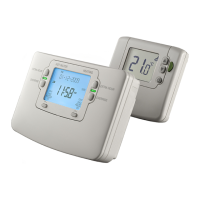
Do you have a question about the Honeywell Y9420H Sundial RF2 Pack 2 and is the answer not in the manual?
| Model | Y9420H |
|---|---|
| Frequency | 868 MHz |
| Power Source (Thermostat) | 2 x AA Batteries |
| Power Source (Receiver) | 230V AC |
| Operating Temperature Range | 0°C to 40°C |
| Setpoint Range | 5°C to 35°C |
| Frost Protection | Yes |
| Control Type | Wireless |
| Display | LCD |
| Programming | 7-day programmable |
| Temperature Range | 5°C to 35°C |
| Communication Protocol | RF (Radio Frequency) |
| Range | 30m |
| Warranty | 2 years |
| Wireless Range | 30m |
| Compatibility | Most boilers and heating systems |
Overview of the Honeywell ST9420C programmer and its role in heating and hot water control.
Guidance on setting heating and hot water programmes based on lifestyle and house heat-up times.
Instructions for using the room thermostat and understanding system optimisation features for comfort and efficiency.
Step-by-step guide to setting the date and time on the ST9420C programmer.
Information on operating the ST9420C using its pre-designed heating and hot water programmes.
Details of the factory-set programme profiles (A, b, C) available for the ST9420C.
Instructions for setting or changing the ON/OFF times for the hot water system.
Instructions for setting or changing the ON/OFF times for the heating system.
Method for disabling or re-enabling specific heating or hot water time periods.
Guide to selecting between OFF, AUTO, ONCE, and CONT modes for heating and hot water.
How to temporarily switch heating or hot water ON or OFF without altering the main programme.
Extending heating or hot water ON periods by up to three hours.
Setting the system to switch off for a specified period when away from home.
Accessing and viewing system information, such as room and water temperatures.
Switching between 12-hour AM/PM and 24-hour clock formats on the ST9420C.
Adjusting system settings and preferences via the Installer Mode parameters.
Details on how Optimum Start, Delayed Start, and Optimum Stop features work.
ST9420C displays a countdown until the next boiler service is due.
Indication and action required when the boiler service is overdue.
What happens when the boiler service is overdue and the system shuts down.
How to check and change the set temperature using the DT92E room thermostat.
Turning the DT92E thermostat ON/OFF or into standby mode.
Understanding display updates, hourglass symbol, and heating indicators.
How the frost protection feature is indicated and when the boiler is switched on.
Identifying low battery levels and instructions for replacing DT92E batteries.
Understanding the RF symbol indicating communication status between devices.
Explanation of the lockout symbol and when overrides from the DT92E are restricted.
How to activate ECO mode and set the duration for energy-saving temperatures.
Description of the display during ECO mode, including countdown and temperature adjustments.
Instructions for deactivating ECO mode and returning to the previous set temperature.
Guide to adjusting specific settings for the DT92E thermostat via Installer Mode.
Procedure for correcting the time on the ST9420C programmer.
Information on automatic clock adjustments for daylight saving changes.
Tips for recovering from programming errors or confusion on the ST9420C.
How power failures affect the ST9420C and its programme retention.
Troubleshooting steps for when RF communication between devices is lost.
Guidance on when and how to replace batteries in the DT92E thermostat.
Possibility of overriding heating from the DT92E, dependent on ST9420C mode.
Tables for installers to record ST9420C and DT92E configuration settings.
Space to record service dates, engineer details, and contact information.
Advice on maximizing energy efficiency and reducing carbon emissions with heating controls.
Explanation of programmer functions and how they control heating and hot water systems.
Explanation of how room thermostats sense temperature and control heating systems.
